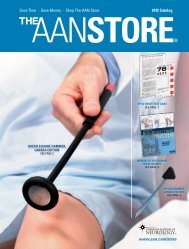Read the Case-Based Curriculum for Neurology Residents.
Read the Case-Based Curriculum for Neurology Residents.
Read the Case-Based Curriculum for Neurology Residents.
Create successful ePaper yourself
Turn your PDF publications into a flip-book with our unique Google optimized e-Paper software.
wayward practitioners (including inappropriate prescriptive practices). Srate govemors appoint<br />
board members, whose qualifications vary considerably from state to state- There is considerable<br />
diversity in <strong>the</strong> language of different states'HPAS, each requiring inrerpretarion, ranging from<br />
encouraging to threatening. No systematic analysis exists srare-by-srate; <strong>the</strong> individual physician<br />
is responsible <strong>for</strong> understanding <strong>the</strong> applicable regulations in his or her own jurisdiction. It rs<br />
<strong>the</strong>re<strong>for</strong>e at <strong>the</strong> state ievel that physician uncertainty is most intense conceming <strong>the</strong> boundaries of<br />
permissible opioid prescribing practices. one "chilling effect" is physician uncenainty over whar<br />
indications, duration, and overall volume of opioid prescription will create a "high profile" <strong>for</strong><br />
state (and federal) regularors, triggering a license-threatening and potentially criminal<br />
rnvestigadon.<br />
Some states have recently adopted detailed guidelines <strong>for</strong> ongoing prescription controlled<br />
substances <strong>for</strong> chronic nonmalignant pain. A few all but prohibit it (20). Most arc in <strong>the</strong> middle,<br />
limidng dosing beyond "usual and recommended" dose ranges and durations, imposing<br />
restricrions on dose unirs unrelared to indication (e.g., to 120 pills irrespective ofpotency),<br />
restrict opioids ro specific indications, limiting phone refills to emergencies, restricting who may<br />
pick up prescriptions, impose onerous records keeping rules, and establishing multipte-copy<br />
prescription programs (MCPP, "triplicate <strong>for</strong>ms"). ln <strong>the</strong> ten srares currently with MCpp laws,<br />
one copy goes ro <strong>the</strong> srare police or drug en<strong>for</strong>cemenr agency. The tighrer <strong>the</strong> rcstdctions, <strong>the</strong><br />
harder a time patients have in locating pharmacies (operating under <strong>the</strong>ir own regulations) rhat<br />
stock strong narcot.icsuch as hydromorphone, oral morphine, or methadone-class drugs. (21)<br />
B. Identification of <strong>the</strong> Ethical problem(s)<br />
7- what are <strong>the</strong> ethicar probrems in this case? (rfappropriate, rank by magnitude)<br />
A well-documented feature of contemporary medical practice is <strong>the</strong> widispread<br />
undenrearment by physicians of moderate ro severe pain, through underdosing or outrighi<br />
w.ithholding. Panicularly vulnerable populations include women, <strong>the</strong> elderly, and minorities. To<br />
withhold or fail to refer <strong>for</strong> <strong>the</strong> sole rcmaining class of analgesics that mighi relieve a patient's<br />
refractory CNP <strong>for</strong> no rcason o<strong>the</strong>r than undue fear of causing iatrogenic addiction abiicates <strong>the</strong><br />
physician's traditional role in rclieving suffering and effectively tolerares avoidable disability.<br />
It must be noted that opponents of opioids <strong>for</strong> cNp argue <strong>for</strong> a less biomedical and more<br />
biopsychosocial model of pain managcment, that shifts <strong>the</strong> locus of responsibility <strong>for</strong> cNp<br />
control from physician prcscribing to parient responsibility <strong>for</strong> modifiable factors, especially<br />
habitual and psychologic or behaviora.l (here weight reduction, smoking cessation, and perhaps<br />
biofeedback or o<strong>the</strong>r nonpharmacologic modalities of treatment), where <strong>the</strong> explicit goal is to<br />
minimize <strong>the</strong> amounr of opioids acnrally prcscribed. (22,23)<br />
The ER physician's well-meaning recommendation to vcrify compliance by entering <strong>the</strong><br />
patient's name on a metro-wide computer database <strong>for</strong> <strong>the</strong> use of affiliated hospitals carries heavy<br />
risks of breach of confidentiality of highly sensitive in<strong>for</strong>madon withour <strong>the</strong> patient's knowledge<br />
or consenr by employers, and by third parties with no compelling need to know. A much better<br />
strategy is to enter into a <strong>for</strong>mal "conrracr" with <strong>the</strong> patient, specifying that <strong>the</strong>rc will bejust one<br />
prescribing physician, specified amounts <strong>for</strong> well-documented indications, <strong>the</strong> possibilitv of





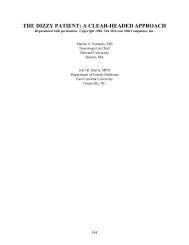

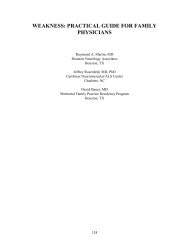
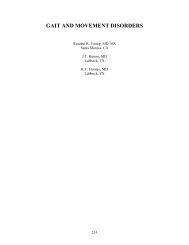
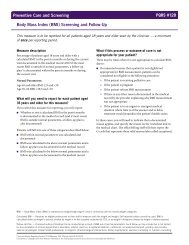
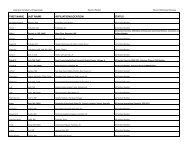
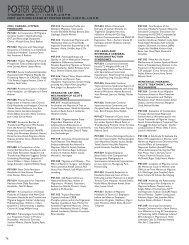
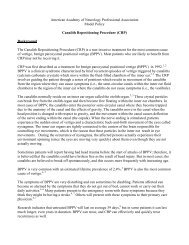
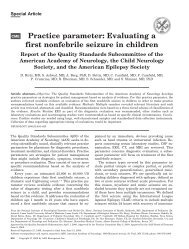

![[Click here and type date] - American Academy of Neurology](https://img.yumpu.com/8582972/1/190x245/click-here-and-type-date-american-academy-of-neurology.jpg?quality=85)
